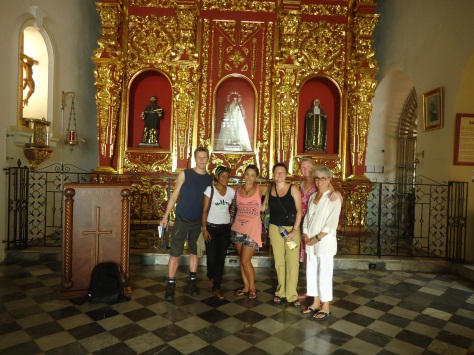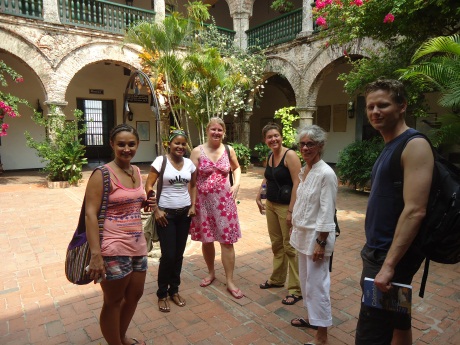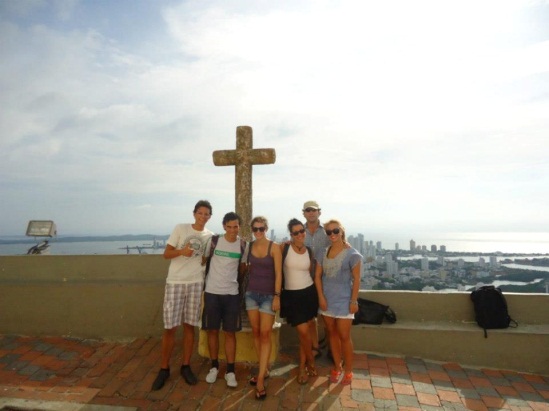Cartagena de Indias is the tourist city of Colombia par excellence. Every corner of Cartagena has a story and today I am going to share with you the legendary and mysterious story of the “Convento de la Popa” or “Convento de la Virgen de la Candelaria”.
The hill of the stern is an imposing mountain located in the city of Cartagena de Indias. The Spanish baptized it "Popa" due to its resemblance to this part of a ship. On its top is a beautiful church and colonial convent built between 1609 and 1611.
The cloister of the La Popa convent is one of the most beautiful in the colonial city of Cartagena and in all of Colombia. It seems that in the years of the Colony there was a Clandestine shrine where the Indians and African slaves worshiped a deity called "Buziriaco" or "Cabro Urí" that had the appearance of a male goat. Legend has it that then Fray Alonso de la Cruz Paredes, who was secluded in the Ráquira desert (Boyacá), received in a dream the order of the Virgin Mary to erect a monastery for him in the highest place of a coastal city. This is how the monk traveled to Cartagena and carried out the ordered mission on the Popa hill. Upon his arrival in the city, he snatched the goat Busiraco and threw it down the slope. Since then the site is known as the Salto del Cabrón and its cult was replaced by that of the venerated image of the Virgen de la Candelaria, a painting of colonial origin that represents the black virgin and that today is the patron saint of the city. from Cartagena de Indias. It is believed that the construction of the temple and convent of La Popa took much longer than expected due to the continuous sabotage of Busiraco in the form of thunder, lightning, rain and gales. In Colonial times and until the abolition of Slavery, the African blacks established in the city and its surroundings had permission to celebrate the Virgen de la Candelaria festivities where they made demonstrations of their celebrations and where the musical rhythm of the Cumbia arose.

In Cartagena the convent of the Virgin of Candelaria is a place that you must visit

Beautiful view of the city of Caretagena from the Cerro de la Popa
In the course of the War of Independence, the La Popa convent was the theater of heroic feats, such as the one carried out on the night of November 11, 1815, when the surprise assault by the besieging troops of the Spanish Pablo Morillo was repulsed.
During the Republic, the Augustinians were forced to abandon the convent and it was abandoned until it was used as a barracks. Indeed, when the liberating troops entered Cartagena, Bolívar settled there with his regiment. Tradition tells that a cannonball, fired from the castle of San Felipe, passed a few centimeters from the head of the Liberator, who was leaning out of a window on the upper floor of the convent.
Then, in 1961 the Convent and the Hermitage were returned to the Augustinians. Currently the convent is home to the Religious Museum, which can be visited together with the formidable cloister.
In February the festival of the Virgen de la Candelaria de La Popa is celebrated. Crowds of devotees make a pilgrimage on foot to the top of Cerro de la Popa; religious festival that culminates in a procession with the image of the Virgin.


Tourists and locals visit the convent, now a museum - Many people make a pilgrimage to Cerro de la Popa
Cerro de la Popa is the best place for natives and foreigners to appreciate the Heroic City in all its splendor with all its contrasts. From this place you can clearly see the Caribbean Sea, the Walled Center, La Boquilla, the north area and the city in general.
This is one of the recommended and obligatory places for all tourists who come to Cartagena de Indias because there they find a Cartagena Religious and History Museum; The Convent of the Holy Cross, in whose Chapel is the miraculous image of the Virgen de la Candelaria; and finally the most beautiful view of the city.
If you want to enjoy historic Cartagena, Nueva Lengua Tours teaches you.
By: Jesús Pedraza
All the articles in this blog have been written by the teachers of our school and by students from different countries who traveled to Colombia to learn Spanish.
“You travel too and study Spanish in NUEVA LENGUA"
Follow us on our social networks:
RELATED VIDEOS
MEDELLÍN - GUADUAS
